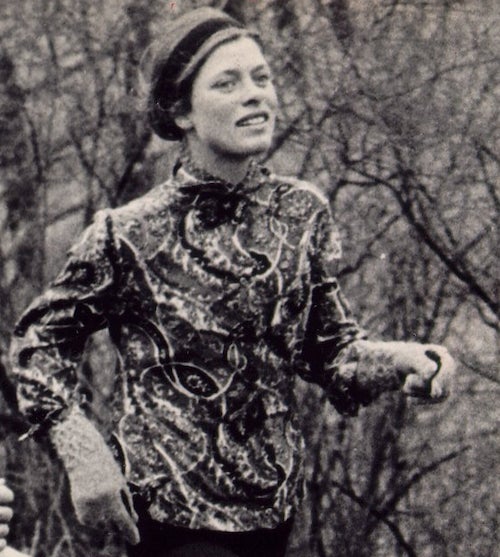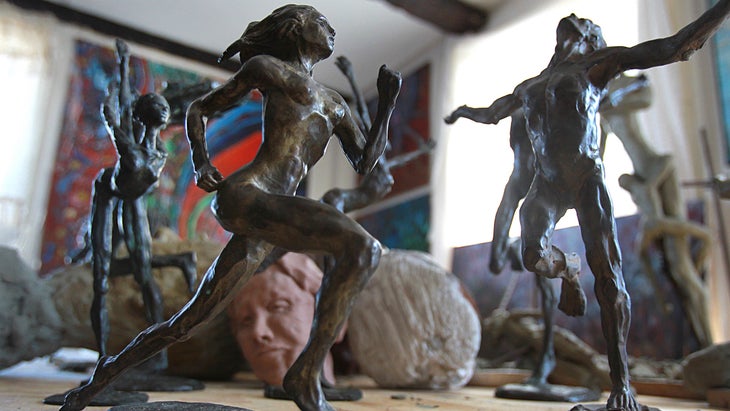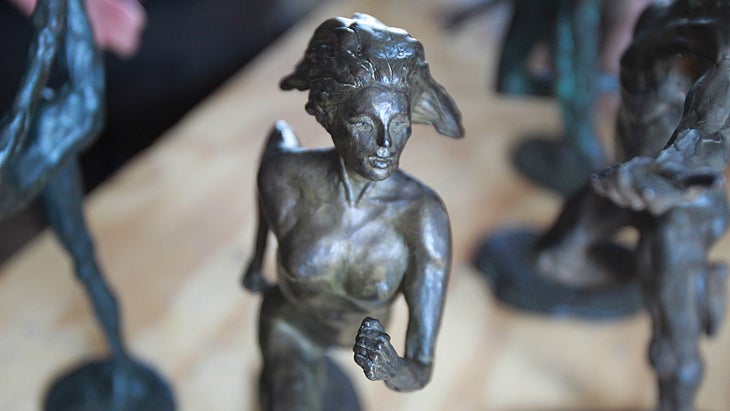Products You May Like
Heading out the door? Read this article on the new Outside+ app available now on iOS devices for members!
Download the app.
This article is part of Women’s Running’s complete 2023 Boston Marathon race coverage.
Bobbi Gibb hopes people are inspired to do what they love when they see her sculptures, many of which feature women running. From an early age, the 80-year-old artist has always embraced what she loves to do, even in the face of opposition.
In 1966, Gibb became the first woman to unofficially run the Boston Marathon. After getting a letter of rejection from race organizers, who told her “women are not physiologically able to run marathon distances,” Gibb hid in the bushes near the start in Hopkinton, jumped in, and ran anyway.
In the year leading up to the race, Gibb trained herself while traveling across the country in her van, sometimes running up to 40 miles at a time. She saw the Boston Marathon as an opportunity to change perceptions of women, who were then discouraged from having careers, let alone running in public.
“I figured, if I could prove this false belief about women running, I could throw into question all the other false beliefs,” Gibb told Women’s Running. “If a woman can run a marathon, what else can she do?”
While it took several years and many fellow activists fighting for inclusion, the Boston Marathon eventually created an official women’s division in 1972. Today, Gibb is considered a trailblazer in the sport, but her contributions extend beyond her running accomplishments. Through moving artwork, she continues to honor the women’s running pioneers that changed the sport forever.
RELATED: Statue Honoring Boston’s First Female Finisher is Unveiled

Following Her Aspirations
Growing up in Winchester and Rockport, Massachusetts, Gibb started drawing and painting at an early age and continued it as a hobby throughout her adult life. Over the years, she developed into a multihyphenate, studying math and physics at Tufts University, despite her mother’s concerns at the time.
“I could see the cage that women had to live in,” Gibb said, while explaining that her mother wanted to be a reporter but was confined, like most women of her generation, to the home without opportunities to develop her gifts. “I said, ‘I’m not going to fall into this trap.’ All of her friends were the same way, very unhappy, and most of them took tranquilizers and drank wine to get through.”
In 1964, Gibb watched her first marathon and became inspired to try running. That summer, she took her dog and headed west in her parents’ Volkswagen. Every day, she ran in a different area, through the Great Plains of the Midwest and up the Rocky Mountains, among other stops along the route. At night, she slept under the stars and marveled at the science behind the solar system. When she finished her cross-country road trip at Stinson Beach, just north of San Francisco, Gibb decided to move to the Golden State and train for the Boston Marathon.
RELATED: Bobbi Gibb Discusses Changing Social Consciousness Through Running

“Something inside me just said, ‘You’re going to run that race,’” Gibb said. “It’s like falling in love. It makes no sense.”
From 1966 to 1968, Gibb didn’t run the Boston Marathon with an official race bib, but she was the first female finisher each time. She later became a lawyer and practiced law for 18 years. At the same time, she continued her artwork as a hobby.
In a late 1970s interview with Runner’s World, Gibb was photographed in her studio, which contained a sculpture of a woman running. When the story was published, requests flooded in from readers who wanted to know how they could purchase the piece. The response made Gibb realize she could turn sculpting into a career. So, she phased out her law practice and transitioned to art full time.

Bringing Attention to Women
Now living in Gloucester, just north of Boston, Gibb still runs most days. If the weather conditions are too harsh, she runs inside on her mini trampoline. Her perspective as a runner, combined with her knowledge of human anatomy, helps inform her sculpting style, which beautifully captures the muscle strength and movement in a runner’s form. For Gibb, featuring women who run is her way of honoring them.
“Historically, women have been either submerged, made invisible, or prevented from manifesting their gifts,” Gibb said. “I want to bring attention to the fact that we have just as many women geniuses as men.”
In 1984, Gibb was commissioned by Laurel James, the organizer of the first women’s U.S. Olympic Trials Marathon in Olympia, Washington, to create trophies for the podium finishers. Joan Benoit Samuelson famously won the race and went on to win Olympic gold later that year in Los Angeles.
In 2016, Gibb’s contributions to the sport were honored by the Boston Athletic Association (B.A.A.), the organization that hosts the Boston Marathon. The 26.2 Foundation commissioned her to create a sculpture of a woman running the race. Gibb said she set out to create a sculpture of Benoit Samuelson at first, but the two-time Boston winner insisted she create one of herself instead.
The piece was unveiled in 2021 and will be the first sculpture of a woman on the course.

For now, the life-size statue is located at the Hopkinton Center for the Arts in a gallery showing called “Break Away.” According to the museum’s website, the installation aims to celebrate women’s empowerment in honor of women’s history month through the works of Gibb and fellow artist Chelsea Bradway.
On April 16, the day before Marathon Monday, Gibb is scheduled to speak at the gallery, where she’ll share the story behind the courage she hopes her work inspires.
“I believe that every person came here with a gift to give to the world to make the world better,” Gibb said, “and I hope that this art that I do out of love helps people get in tune with that love, whether it’s through art or running or whatever we came here to give.”
